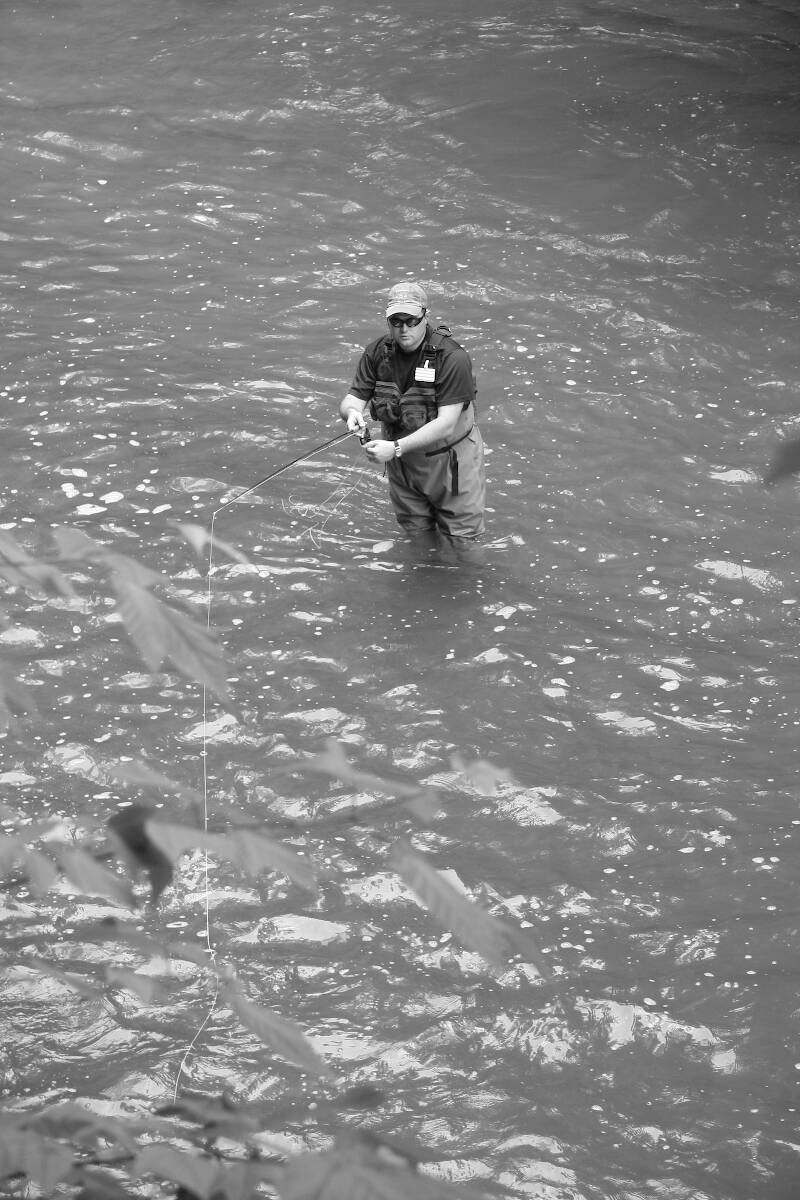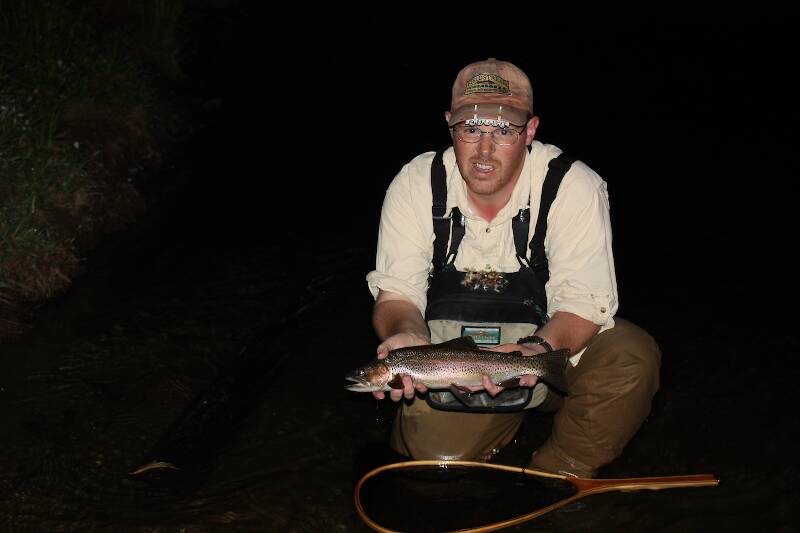
Blue-winged Olives
Baetis
Tiny Baetis mayflies are perhaps the most commonly encountered and imitated by anglers on all American trout streams due to their great abundance, widespread distribution, and trout-friendly emergence habits.
Featured on the forum

This specimen keys pretty easily to Onocosmoecus, and it closely resembles a specimen from Alaska which caddis expert Dave Ruiter recognized as this genus. As with that specimen, the only species in the genus documented in this area is Onocosmoecus unicolor, but Dave suggested for that specimen that there might be multiple not-yet-distinguished species under the unicolor umbrella and it would be best to stick with the genus-level ID. I'm doing the same for this one.

Troutnut is a project started in 2003 by salmonid ecologist Jason "Troutnut" Neuswanger to help anglers and
fly tyers unabashedly embrace the entomological side of the sport. Learn more about Troutnut or
support the project for an enhanced experience here.
Lastchance on Sep 20, 2009September 20th, 2009, 10:12 am EDT
I'm not happy with my dubbing mix for tying the ISO nymph or my pattern. My pattern seems too bulky--just doesn't seem right. Any suggestions on a general dubbing mix would be appreciated. I like to experiment.
Thanks,
Bruce
Thanks,
Bruce
Taxon on Sep 20, 2009September 20th, 2009, 3:16 pm EDT
Hi Bruce-
"Too bulky" sounds like you may be applying too much dubbing to the thread, but without seeing a photo of your tie, giving you any useful advise would be problematic at best.
"Too bulky" sounds like you may be applying too much dubbing to the thread, but without seeing a photo of your tie, giving you any useful advise would be problematic at best.
Oldredbarn on Sep 21, 2009September 21st, 2009, 3:52 am EDT
Bruce,
You should search out Softhackle's web page and look at his flies there. He has an Iso nymph that I stole to some profit recently with the smallies in a nearby river here. He ties some really beautiful flies and maybe it's his artist background, but in my humble opinion, the proportions are pretty much dead on. You would be hard pressed to find nicer tied flies.
The larger bugs are sometimes problematic. On the one hand they are bigger, but they are still mayflies, and should have a slender abdomen. If you have read Syl Nemes' "Spinners" book of a few years back, he actually took a micrometer to some bugs. He found that in many cases the diameter of an abdomen is barely bigger that the diameter of the hook. He, therefore uses only the tying thread to form a lot of the bodies on his spinners.
I personally prefer a dubbed body and my fly fishing mentor use to tease me that my mayfly imitations needed to be put on "Weight Watchers"...My retort was then, "If you were a trout would you chase a slow little "fatso" chock-full of caloric goodness or that skinny little sprinter you tie up!" This didn't fly of course and I strive for the slender in my imitations.
Less is better, probably more than we think with out mayfly patterns...at least in the slower running streams of the mid-west. You can maybe look in to a dubbing loop. This sometimes will bind everything down tighter and then wrap your body. Sometimes in can even give you some segmentation that exists on the natural.
Mark...a.k.a. "Softhackle" uses a technique developed by his "muse" James Leisenring. You actually create your bodies on a device and set them off to the side for when you actually need them.
I prefer natural furs for my bugs especially beaver, but some of the "Super-Fine" stuff on the market can be applied really thin and create a nice body.
My friend Willy would just tell you to practise more...I heard a story about him from the late 70's where he taught fly tying at a fishing club. He would send guys home and tell them to report next week with so many dozen of a particular pattern...He would then sit down with a waste paper basket between his legs and if your fly didn't pass muster...in to the basket it would go...You either love this guy or you don't.
Good luck! You will get it. The first step, I feel, is that you are aware something isn't quite up to your standards and you are striving to fix it.
You can try quill bodies as well...They are nice.
Take Care!
Spence
You should search out Softhackle's web page and look at his flies there. He has an Iso nymph that I stole to some profit recently with the smallies in a nearby river here. He ties some really beautiful flies and maybe it's his artist background, but in my humble opinion, the proportions are pretty much dead on. You would be hard pressed to find nicer tied flies.
The larger bugs are sometimes problematic. On the one hand they are bigger, but they are still mayflies, and should have a slender abdomen. If you have read Syl Nemes' "Spinners" book of a few years back, he actually took a micrometer to some bugs. He found that in many cases the diameter of an abdomen is barely bigger that the diameter of the hook. He, therefore uses only the tying thread to form a lot of the bodies on his spinners.
I personally prefer a dubbed body and my fly fishing mentor use to tease me that my mayfly imitations needed to be put on "Weight Watchers"...My retort was then, "If you were a trout would you chase a slow little "fatso" chock-full of caloric goodness or that skinny little sprinter you tie up!" This didn't fly of course and I strive for the slender in my imitations.
Less is better, probably more than we think with out mayfly patterns...at least in the slower running streams of the mid-west. You can maybe look in to a dubbing loop. This sometimes will bind everything down tighter and then wrap your body. Sometimes in can even give you some segmentation that exists on the natural.
Mark...a.k.a. "Softhackle" uses a technique developed by his "muse" James Leisenring. You actually create your bodies on a device and set them off to the side for when you actually need them.
I prefer natural furs for my bugs especially beaver, but some of the "Super-Fine" stuff on the market can be applied really thin and create a nice body.
My friend Willy would just tell you to practise more...I heard a story about him from the late 70's where he taught fly tying at a fishing club. He would send guys home and tell them to report next week with so many dozen of a particular pattern...He would then sit down with a waste paper basket between his legs and if your fly didn't pass muster...in to the basket it would go...You either love this guy or you don't.
Good luck! You will get it. The first step, I feel, is that you are aware something isn't quite up to your standards and you are striving to fix it.
You can try quill bodies as well...They are nice.
Take Care!
Spence
"Even when my best efforts fail it's a satisfying challenge, and that, after all, is the essence of fly fishing." -Chauncy Lively
"Envy not the man who lives beside the river, but the man the river flows through." Joseph T Heywood
"Envy not the man who lives beside the river, but the man the river flows through." Joseph T Heywood
Flatstick96 on Sep 22, 2009September 22nd, 2009, 5:18 am EDT
Here is the one I tie; when you get to the below page, click the drop down list, go to the VERY bottom, and select "The Isonychia Nymph".
http://www.flyfishersparadise.com/articles_display.php?category=Online_Tying_Manual&archive=true
http://www.flyfishersparadise.com/articles_display.php?category=Online_Tying_Manual&archive=true
Shawnny3 on Sep 22, 2009September 22nd, 2009, 12:37 pm EDT
As with a lot of nymphs, I've seen quite a bit of color variation in natural Isos, from pale brown to deep purplish brown. If I were you, I would do some seining in the streams in which you want to use them and see what you come up with. I suppose, though, that the coloration of the nymphs probably changes somewhat throughout the seasons. Others more knowledgeable than I could comment to that. But something to consider - color is often not constant from bug to bug or over time.
That said, I like the dark version my brother (Flatstick) suggests. It gives the fly a really strong profile in the water, and it fills a color void in my flybox. I also like how the dark color gives the white line on top a lot of contrast. I'll often use this dark version (the bigger the better) as a searching pattern when the water is up and off-color even if nothing with Isos is really happening. It's a fine searching pattern even in streams without Isos. In fact, I know my brother's biggest trout was taken on this nymph on a stream with no Iso population at all. But I forget how big that fish was and can't for the life of me remember the name of that stream.
Finally, and not knowing anything about your tying skills I hope I don't offend you, Bruce, I wonder if you're laying the dubbing on too heavily. While it's tedious to use sparse dubbing technique when tying a large fly, be careful that in your haste to finish the body you aren't dubbing the thread with gobs and gobs of dubbing (I am certainly guilty of this, and I often have to tell myself to slow down and do it right). It shouldn't get too bulky if you use an appropriate amount of dubbing on each turn.
-Shawn
That said, I like the dark version my brother (Flatstick) suggests. It gives the fly a really strong profile in the water, and it fills a color void in my flybox. I also like how the dark color gives the white line on top a lot of contrast. I'll often use this dark version (the bigger the better) as a searching pattern when the water is up and off-color even if nothing with Isos is really happening. It's a fine searching pattern even in streams without Isos. In fact, I know my brother's biggest trout was taken on this nymph on a stream with no Iso population at all. But I forget how big that fish was and can't for the life of me remember the name of that stream.
Finally, and not knowing anything about your tying skills I hope I don't offend you, Bruce, I wonder if you're laying the dubbing on too heavily. While it's tedious to use sparse dubbing technique when tying a large fly, be careful that in your haste to finish the body you aren't dubbing the thread with gobs and gobs of dubbing (I am certainly guilty of this, and I often have to tell myself to slow down and do it right). It shouldn't get too bulky if you use an appropriate amount of dubbing on each turn.
-Shawn
Jewelry-Quality Artistic Salmon Flies, by Shawn Davis
www.davisflydesigns.com
www.davisflydesigns.com
JOHNW on Sep 23, 2009September 23rd, 2009, 9:06 am EDT
Bruce,
The recipie flatstick gave you is a good one.
I tie a variation on it whereby I replace the peacock swords with marabou stubs (a use for the butt ends you have left after tying sculpins or buggers) of varying colors. I have found the accent coloring in the tails can change my overall peception of the shading of the dubbing. Secondly I replace the white stripe on the back with a single strand of flashabou. All in all both patterns work the same for me but I just like the look of my variation in my flybox.
JW
The recipie flatstick gave you is a good one.
I tie a variation on it whereby I replace the peacock swords with marabou stubs (a use for the butt ends you have left after tying sculpins or buggers) of varying colors. I have found the accent coloring in the tails can change my overall peception of the shading of the dubbing. Secondly I replace the white stripe on the back with a single strand of flashabou. All in all both patterns work the same for me but I just like the look of my variation in my flybox.
JW
"old habits are hard to kill once you have gray in your beard" -Old Red Barn
Lastchance on Sep 24, 2009September 24th, 2009, 11:54 am EDT
Hi: I can't see all of the patterns on the FFP site for some reason, my computer won't allow me to scroll to the bottom of the list. I'll give it a try tomorrow at work. I plan on fishing The Little J on Saturday so I'll tie a few up tomorrow afternoon.
Thanks Guys,
Bruce
Thanks Guys,
Bruce
Martinlf on Sep 24, 2009September 24th, 2009, 1:05 pm EDT
Bruce, play around with the mouse some. The FFP site is funny and sometimes you have to slide a direction bar around or something to see what you're looking for. I remember having trouble with this myself, then seeing how to do it. It's confusing until you see what to slide where. They have a scroll bar on the right on the main page. Scroll down to "articles," click on that, then click on "archives." Then you'll have to hunt through the different categories until you find the pattern. It's worth it and fun; they have lots of good patterns there for other flies too. Or you can click on "information" on the left on the home page, then "archives" and get there too.
"He spread them a yard and a half. 'And every one that got away is this big.'"
--Fred Chappell
--Fred Chappell
Flatstick96 on Sep 25, 2009September 25th, 2009, 4:30 am EDT
The J, eh? I've managed some particularly nice fish from the J on that FFP Iso pattern.
Quick Reply
Related Discussions
Topic
Replies
Last Reply
4
May 17, 2010
by Lastchance
by Lastchance
Re: Lots of new pictures to check out, coming online tonight/tomorrow
In General Discussion by Troutnut
In General Discussion by Troutnut
1
Oct 4, 2006
by Dinerobyn
by Dinerobyn






